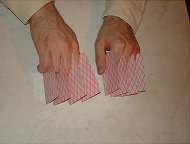Couple
Ask any viewer to put his hands on the table, as if he is going to play the piano.
Take two top cards from the deck and put them between the ring finger and the little finger of the right hand of the viewer.
The spectator must clamp these cards.
Next, take the next two cards from the top of the deck and put it between the ring finger and middle finger and so on, fill all the gaps between the fingers.
First, do this on your right hand, and then on the left, and in the last interval between the ring finger and the little finger of the left hand, you must put one card.

Thus, both hands of the spectator turned out to be filled with maps: between the fingers of the right hand there are 4 paired cards, and between the fingers of the left hand there are 3 paired and one unpaired card.
As a result, 15 cards were obtained.
Now take from the right hand the first pair of cards and divide it, while putting the cards face down on the table at a distance of 10 centimeters from each other.
In the same way, divide the next pair of cards, and put the cards from the next pair on top of the previous ones.
As a result, on the table there will be 2 stacks of 7 cards in each pile, and the spectator will have one unpaired card between his fingers.
You must take this card and put it on one of the two piles, or rather on the pile where you will be directed by the audience.
Then show that an even number of cards becomes odd and vice versa.
That's all you need to do in this focus.
The idea of the focus is that when you insert the map viewer between your fingers, you constantly say the word "couple - pair - pair - pair", thus, lulling the viewer 's vigilance, and the viewer thinks that you put his paired cards in his fingers , Although in fact in the last interval of fingers you insert not a pair card.
And when you start to disassemble all the cards between your fingers, the viewer suddenly has one card not pairing.


Comments
When commenting on, remember that the content and tone of your message can hurt the feelings of real people, show respect and tolerance to your interlocutors even if you do not share their opinion, your behavior in the conditions of freedom of expression and anonymity provided by the Internet, changes Not only virtual, but also the real world. All comments are hidden from the index, spam is controlled.